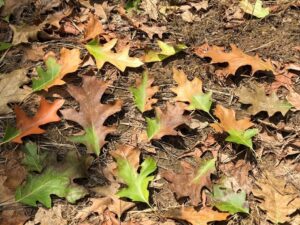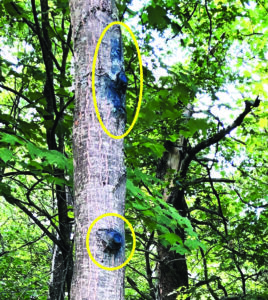
Discolored fallen leaves from a red oak tree indicate that the tree is infected with oak wilt. / Photo Credit: Wisconsin DNR
By Art Kabelowsky, DNR Forest Health Outreach and Communications, Fitchburg Service Center;
Arthur.Kabelowsky@wisconsin.gov or 608-335-0167
With the weather taking its time to turn wintry, it’s a good time to remind landowners and work crews that now through the end of March is an ideal time to perform pruning, trimming and brush removal on and near oak trees.
This is a low-risk period for the trees to be infected with oak wilt, a fungal disease spread by beetles. When a red oak is infected with oak wilt, it will die that year. The disease also stresses white oaks, often proving fatal.
The pervasive and deadly disease has been found in 65 of Wisconsin’s 72 counties after first being documented in the state in 1944. The fungus is spread by beetles feeding on sap from recently damaged oak. They seek out broken branches, pruning cuts and even damaged bark.

Pruning wounds on an oak tree are covered by tree-wound paint (circled in yellow) after workers learned that leaving the wounds untreated could lead to oak wilt infection. / Photo Credit: Linda Williams, Wisconsin DNR
After one tree in a stand gets oak wilt, the disease will likely spread through the root system to kill neighboring oak trees in future years, creating an ongoing problem for crews trying to keep roads free of hazardous trees.
Landowners and workers should remember that in the spring, even if they are cutting down trees that aren’t oaks – ash trees killed by emerald ash borer, for instance — those trees may damage oaks as they fall.
“Doing work like this before April 1 or after July 15 will minimize the risk to oaks in the area,” said Linda Williams, DNR Forest Health Specialist. “You can protect the oak and still get your work done by doing the work now (or) before April 1.”
Williams also said that if landowners or crews prune or accidentally wound oak trees during the high-risk period, they should carry tree-wound paint and immediately cover all exposed wounds.
Trees in the red oak group – including northern red, northern pin and black oak – infected in the spring will die by fall, creating a hazard, expense and added workload for town crews. Trees that have died of oak wilt can harbor spores for about a year after death in fungal mats under the bark, and beetles can pick up spores from those mats and carry them to freshly damaged oaks.
For more information about oak wilt, including harvesting tips, an interactive guide and maps, please visit https://bit.ly/WIOakWilt. To subscribe to the DNR’s Forest Health newsletter, please visit https://bit.ly/ForHealthNews.
